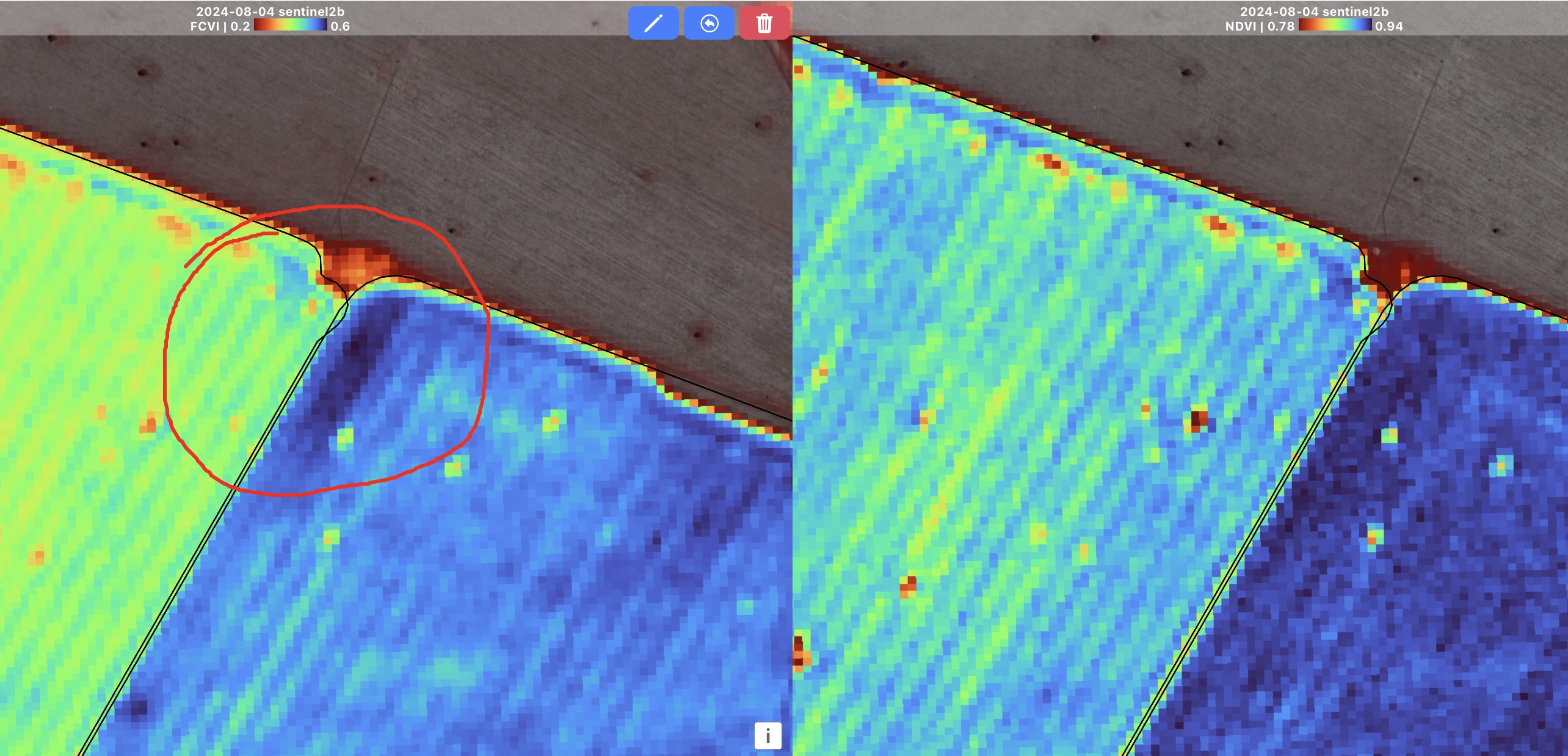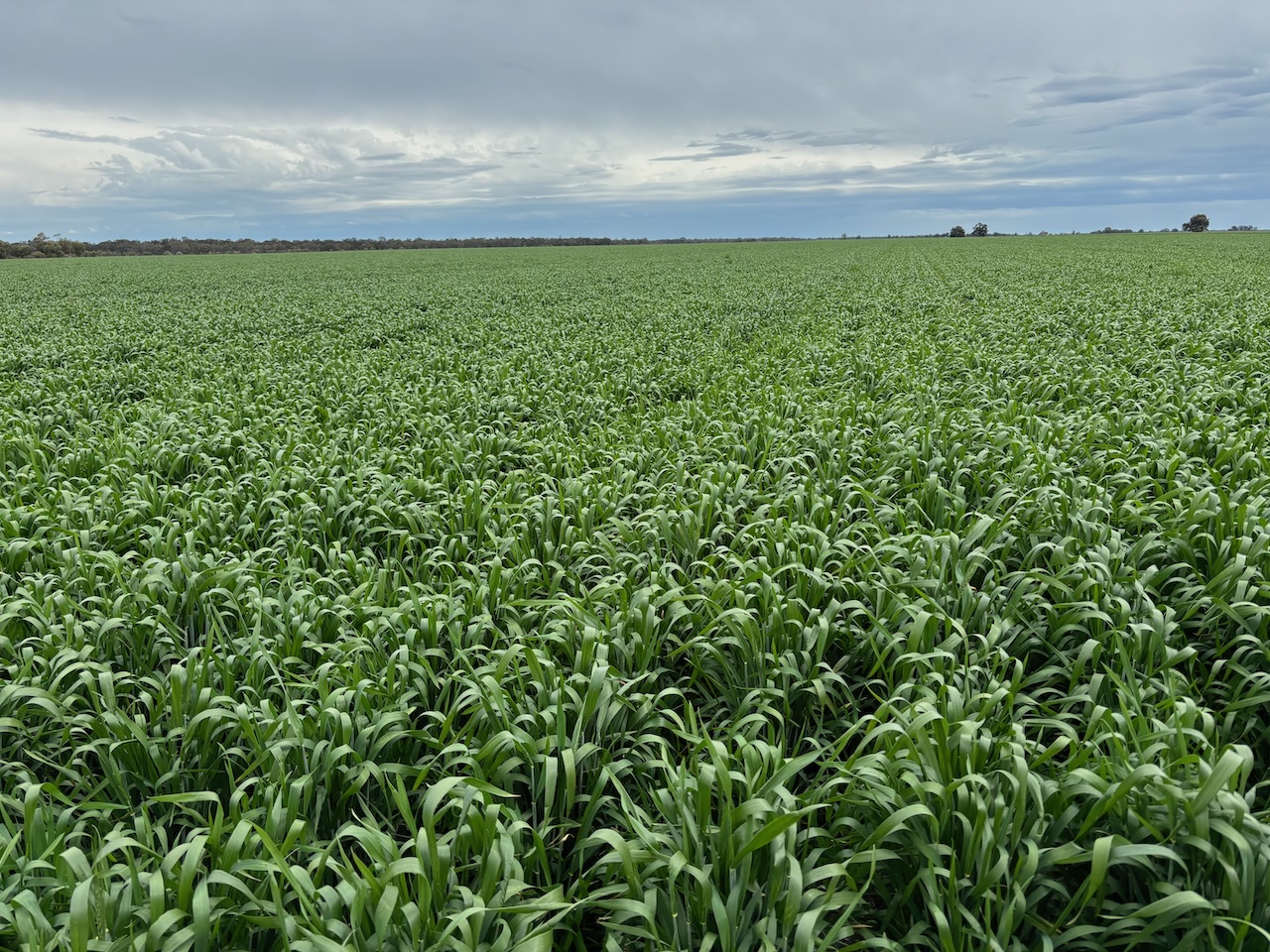A wheat example
Lets start with the example then explain FCVI. Looking at field on the right - to the human eye this wheat crop looks amazing from the ground. Deep green, minimal leaf disease and very even. The crop adjacent (Murray's Corner) required a urea application as it was, and still is showing signs of nitrogen deficiency. There was some left over so I applied a small strip on to the healthy field to see the respone. When examing the field with NDVI and MCARI2 no difference is detected. FCVI however shows the strip very clearly. The crop has more photosynthetic activity where the urea was applied. I expect more yield here.


Overview
The Fluorescence Correction Vegetation Index (FCVI) represents a significant advancement in the remote sensing of vegetation, offering improved insights into plant physiological processes compared to traditional indices like the Normalized Difference Vegetation Index (NDVI). Developed by a team of researchers from the University of Twente, NASA Goddard Space Flight Center, and the University of Maryland, FCVI provides a refined method for monitoring vegetation, especially under conditions where other indices fall short.
How FCVI Works
FCVI is calculated using the difference between near-infrared (NIR) reflectance and broadband visible (VIS) reflectance:
FCVI = RNIR - RVIS
In this formula:
- RNIR: Reflectance in the near-infrared region, typically between 750-900 nm.
- RVIS: Average reflectance across the visible spectrum (400-700 nm).
The index is specifically designed to separate physiological information, such as photosynthetic activity, from non-physiological factors like canopy structure and soil background. This is achieved by leveraging the broad range of visible reflectance data, allowing FCVI to better capture the subtle differences in vegetation health and function.
Why FCVI is Better Than NDVI
- Reduced Saturation in High Biomass Conditions: Unlike NDVI, which often saturates in dense vegetation, FCVI maintains sensitivity across a wide range of biomass levels. This makes it particularly valuable in monitoring high-rainfall and high-biomass crops, such as wheat, barley, and chickpeas, where NDVI can become less informative due to its plateauing nature.
- Enhanced Sensitivity to Physiological Changes: By incorporating a broader spectrum of visible light, FCVI is more responsive to changes in photosynthetic efficiency and plant stress. It can distinguish between variations caused by physiological processes and those due to structural changes, providing a clearer picture of plant health.
- Application in Various Conditions: FCVI's design allows it to be effective across different canopy structures and soil types, making it a versatile tool in diverse agricultural and ecological settings.
Scientific Foundation and Applications
The development and application of FCVI are detailed in a study published in the journal Remote Sensing of Environment. The research team, including Peiqi Yang, Christiaan van der Tol, Petya K.E. Campbell, and Elizabeth M. Middleton, demonstrated FCVI's effectiveness in separating the effects of photosynthetically active radiation (PAR) absorption and SIF scattering. This ability enhances the reliability of remote sensing data for tracking physiological processes throughout natural growth phases and seasons (Yang et al., 2020).
Conclusion
As remote sensing technology continues to evolve, FCVI stands out as a promising tool for researchers and practitioners. It offers a more nuanced understanding of vegetation dynamics, especially in environments where traditional indices like NDVI may not provide sufficient detail. With its ability to reduce saturation and better capture physiological signals, FCVI is poised to play a crucial role in precision agriculture, ecosystem monitoring, and climate studies.
References
Yang, P., van der Tol, C., Campbell, P.K.E., & Middleton, E.M. (2020). Fluorescence Correction Vegetation Index (FCVI): A physically based reflectance index to separate physiological and non-physiological information in far-red sun-induced chlorophyll fluorescence. Remote Sensing of Environment, 240, 111676. https://doi.org/10.1016/j.rse.2020.111676